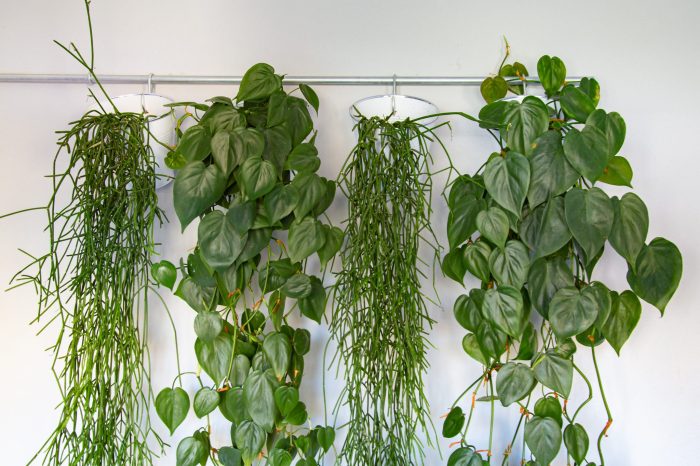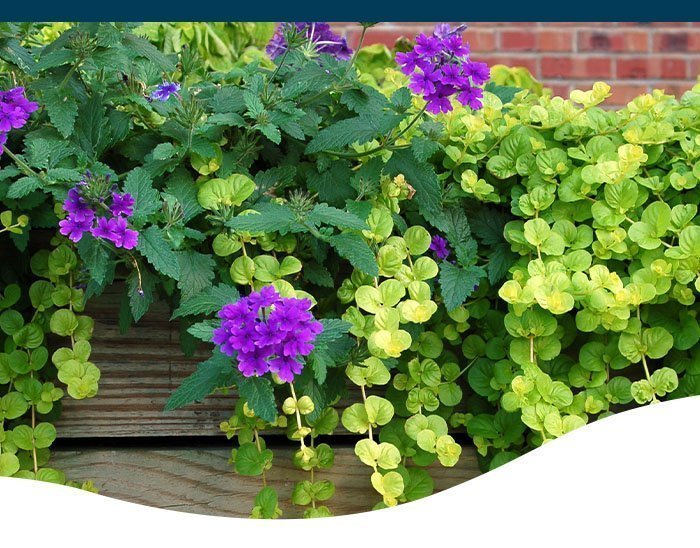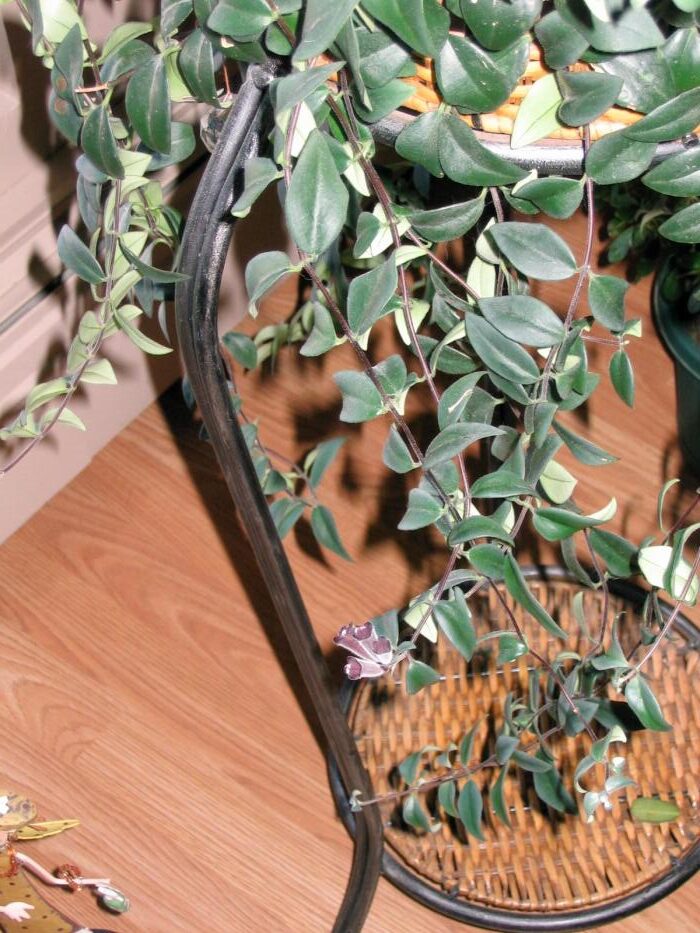Discover the captivating world of mini trailing plants, enchanting greenery that adds a touch of nature’s beauty to any space. These petite plants, with their delicate foliage and cascading growth habits, offer endless possibilities for indoor and outdoor decor.
From vibrant succulents to trailing vines, mini trailing plants come in a diverse range of varieties, each with its unique charm. Whether you seek a lush groundcover, a cascading centerpiece for your hanging basket, or a touch of greenery to brighten up your desk, these versatile plants have something to offer every plant enthusiast.
Mini Trailing Plant Characteristics
Mini trailing plants are renowned for their petite size and cascading growth habit. Typically, they measure between 10-20 cm in length, forming a dense mat of foliage that gracefully trails over the edges of pots or containers.
Mini trailing plants, with their delicate foliage and compact size, are perfect for adding a touch of greenery to small spaces. For those looking for a more dramatic effect, long trailing plants, such as long trailing plants , offer a cascading effect that can transform a room.
However, mini trailing plants remain a versatile and charming option for those seeking a subtle yet impactful way to enhance their indoor spaces.
These plants exhibit diverse shapes and textures. Some varieties, like the Creeping Jenny, display delicate, heart-shaped leaves, while others, such as the Baby’s Tears, showcase tiny, rounded leaves that resemble beads. Their growth habits vary as well, with some forming compact clumps and others spreading out to create a lush, cascading effect.
Mini trailing plants, with their cascading foliage, bring a touch of elegance to any indoor space. For those seeking the perfect plants to adorn their hanging baskets, a comprehensive guide to best plants for hanging baskets indoors offers valuable insights.
Among the recommended options, mini trailing plants stand out for their ability to create a lush, flowing effect that adds a touch of nature to any room.
Common Varieties and Unique Features
- Creeping Jenny (Lysimachia nummularia):Known for its vibrant golden foliage and creeping growth habit, this plant is ideal for ground cover or spilling over containers.
- Baby’s Tears (Soleirolia soleirolii):Featuring minuscule, rounded leaves that resemble beads, this plant creates a dense, moss-like carpet, perfect for terrariums or as a groundcover.
- String of Pearls (Senecio rowleyanus):This unique succulent boasts plump, pea-shaped leaves that resemble strings of pearls. It adds an exotic touch to hanging baskets or tabletop arrangements.
- Purple Heart (Tradescantia pallida):With its deep purple foliage, this trailing plant adds a touch of color to indoor or outdoor spaces. It is known for its rapid growth and tolerance to various conditions.
Suitable Environments
Mini trailing plants are versatile and adaptable to different environments. They thrive indoors in bright, indirect light and well-draining soil. Many varieties are also suitable for outdoor use in shady or partially shaded areas. Some species, like the Creeping Jenny, can even tolerate moist or boggy conditions.
Hanging baskets are a popular choice for displaying mini trailing plants, allowing their cascading foliage to create a stunning visual effect. These plants are also excellent for adding interest to terrariums, where their compact size and low maintenance requirements make them ideal companions for other small plants.
Care and Maintenance
Mini trailing plants require specific care and maintenance to thrive and maintain their vibrant appearance. Understanding their optimal lighting conditions, watering frequency, and soil requirements is crucial for their well-being.
Lighting
These plants prefer bright, indirect light. Avoid exposing them to direct sunlight, as it can scorch their delicate leaves. East or west-facing windows provide ideal lighting conditions.
Watering
Water mini trailing plants thoroughly when the top inch of soil feels dry to the touch. Allow excess water to drain from the pot to prevent waterlogging. Overwatering can lead to root rot, while underwatering can cause the leaves to wilt and brown.
Soil and Fertilization
Use a well-draining potting mix specifically designed for indoor plants. These plants benefit from regular fertilization during the growing season. Apply a balanced liquid fertilizer diluted to half strength every 2-3 weeks.
Propagation Methods
Propagating mini trailing plants is a simple and rewarding process that allows you to increase your collection of these versatile plants. There are three main methods for propagating mini trailing plants: stem cuttings, division, and layering.
Stem Cuttings
Stem cuttings are the most common method for propagating mini trailing plants. To take a stem cutting, use a sharp knife or scissors to cut a 4-6 inch section from a healthy stem. Remove the leaves from the bottom inch of the cutting and dip the end in rooting hormone.
Plant the cutting in a pot filled with well-draining potting mix and keep it moist. Stem cuttings can be taken at any time of year, but they are most successful when taken in the spring or summer.
Mini trailing plants, with their delicate foliage and cascading growth habit, are a popular choice for indoor gardens. Whether adorning a windowsill or cascading over the edge of a planter, these petite beauties add a touch of greenery and visual interest to any space.
For more inspiration on incorporating plants into your home décor, visit Plants , a comprehensive resource for all things plant-related. With a wide variety of mini trailing plants to choose from, you’re sure to find the perfect addition to your indoor oasis.
Division
Division is another easy way to propagate mini trailing plants. To divide a plant, carefully remove it from its pot and gently separate the roots into two or more sections. Each section should have its own roots and a few leaves.
Plant the divisions in individual pots filled with well-draining potting mix and keep them moist. Division is best done in the spring or fall when the plants are actively growing.
Layering
Layering is a less common method for propagating mini trailing plants, but it can be successful if done correctly. To layer a plant, bend a stem down to the ground and cover the middle section with soil. Weigh the stem down with a rock or brick to keep it in place.
Roots will eventually form at the buried section of the stem. Once the roots are established, you can cut the stem below the roots and plant the new plant in its own pot.
By following these simple steps, you can easily propagate mini trailing plants and add more of these beautiful plants to your home or garden.
Design and Landscaping Uses

Mini trailing plants are versatile additions to any indoor or outdoor space, offering a range of design and landscaping possibilities. Their compact size and cascading growth habit make them ideal for various applications, from groundcovers to vertical gardens.
Mini trailing plants are a type of real indoor hanging plants that are perfect for adding a touch of greenery to your home. They are easy to care for and can tolerate a wide range of light conditions. Mini trailing plants are also a great way to add a pop of color to your space.
You can find them in a variety of colors, including green, white, and pink.
When used as groundcovers, mini trailing plants create a lush, dense carpet that suppresses weeds and adds visual interest. They are particularly effective in areas with limited space or where traditional lawn grasses may struggle to grow. In containers, they cascade gracefully over the edges, adding a touch of greenery and softening the overall appearance.
For vertical gardening, they can be trained to climb trellises or walls, creating a living tapestry that adds height and dimension.
Aesthetic Appeal, Mini trailing plant
Mini trailing plants offer a wide range of aesthetic benefits. Their delicate foliage and vibrant colors can add a pop of color and texture to any space. The cascading growth habit creates a sense of movement and fluidity, drawing the eye to the plant.
They can be used to create different effects, such as:
- Adding color:Mini trailing plants with variegated leaves or brightly colored flowers can bring a touch of vibrancy to any setting.
- Creating texture:The different leaf shapes and sizes of mini trailing plants add texture and visual interest to any landscape.
- Adding visual interest:The cascading growth habit of mini trailing plants creates a dynamic and eye-catching effect.
Common Pests and Diseases

Mini trailing plants, despite their delicate appearance, can be susceptible to various pests and diseases that can affect their health and aesthetic appeal. Identifying and addressing these issues promptly is crucial for maintaining the vitality and beauty of these plants.
The most common pests that affect mini trailing plants include aphids, mealybugs, spider mites, and scale insects. Aphids are small, soft-bodied insects that feed on plant sap, causing leaves to curl and distort. Mealybugs are white, cottony insects that attach themselves to stems and leaves, sucking out plant juices.
Spider mites are tiny, spider-like creatures that spin webs on the underside of leaves, causing them to turn yellow and drop off. Scale insects are small, brown or black bumps that attach themselves to plant stems and leaves, feeding on plant sap.
Common diseases that affect mini trailing plants include powdery mildew, botrytis, and root rot. Powdery mildew is a fungal disease that causes a white powdery growth on leaves and stems. Botrytis is a fungal disease that causes brown or gray mold to develop on leaves and flowers.
Root rot is a fungal disease that causes the roots of the plant to rot, leading to wilting and yellowing of leaves.
To prevent pests and diseases, it is important to maintain proper growing conditions for mini trailing plants. This includes providing adequate light, water, and nutrients, as well as ensuring good air circulation. Regular inspection of plants for signs of pests or diseases is also crucial for early detection and treatment.
If pests or diseases are identified, there are various organic and chemical treatment options available. Organic treatments include using insecticidal soap, neem oil, or horticultural oil to control pests. Chemical treatments include using pesticides or fungicides specifically designed for mini trailing plants.
It is important to follow the instructions on the product label carefully when using chemical treatments. Always test the treatment on a small area of the plant first to ensure it does not cause any damage.
Wrap-Up

Whether you’re a seasoned gardener or a novice just starting your plant journey, mini trailing plants are a delightful addition to any collection. Their ease of care, versatility, and aesthetic appeal make them an excellent choice for creating beautiful and thriving indoor and outdoor spaces.
So, embrace the charm of mini trailing plants and let their verdant beauty transform your living environment into a serene and inviting oasis.
FAQ Insights: Mini Trailing Plant
What are the most popular varieties of mini trailing plants?
Some popular varieties include String of Pearls, String of Hearts, Burro’s Tail, and Creeping Jenny.
How often should I water my mini trailing plant?
Water when the soil feels dry to the touch, but avoid overwatering.
Can mini trailing plants tolerate low light conditions?
While they prefer bright, indirect light, some varieties can tolerate low light conditions.
